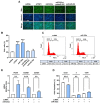Mir-302a/TWF1 Axis Impairs the Myogenic Differentiation of Progenitor Cells through F-Actin-Mediated YAP1 Activation
- PMID: 37047312
- PMCID: PMC10094299
- DOI: 10.3390/ijms24076341
Mir-302a/TWF1 Axis Impairs the Myogenic Differentiation of Progenitor Cells through F-Actin-Mediated YAP1 Activation
Abstract
Actin cytoskeleton dynamics have been found to regulate myogenesis in various progenitor cells, and twinfilin-1 (TWF1), an actin-depolymerizing factor, plays a vital role in actin dynamics and myoblast differentiation. Nevertheless, the molecular mechanisms underlying the epigenetic regulation and biological significance of TWF1 in obesity and muscle wasting have not been explored. Here, we investigated the roles of miR-302a in TWF1 expression, actin filament modulation, proliferation, and myogenic differentiation in C2C12 progenitor cells. Palmitic acid, the most prevalent saturated fatty acid (SFA) in the diet, decreased the expression of TWF1 and impeded myogenic differentiation while increasing the miR-302a levels in C2C12 myoblasts. Interestingly, miR-302a inhibited TWF1 expression directly by targeting its 3'UTR. Furthermore, ectopic expression of miR-302a promoted cell cycle progression and proliferation by increasing the filamentous actin (F-actin) accumulation, which facilitated the nuclear translocation of Yes-associated protein 1 (YAP1). Consequently, by suppressing the expressions of myogenic factors, i.e., MyoD, MyoG, and MyHC, miR-302a impaired myoblast differentiation. Hence, this study demonstrated that SFA-inducible miR-302a suppresses TWF1 expression epigenetically and impairs myogenic differentiation by facilitating myoblast proliferation via F-actin-mediated YAP1 activation.
Keywords: YAP1; differentiation; miR-302a; myogenesis; proliferation; twinfilin-1.
Conflict of interest statement
The authors declare no conflict of interest.
Figures






Similar articles
-
Induction of miR-665-3p Impairs the Differentiation of Myogenic Progenitor Cells by Regulating the TWF1-YAP1 Axis.Cells. 2023 Apr 8;12(8):1114. doi: 10.3390/cells12081114. Cells. 2023. PMID: 37190023 Free PMC article.
-
Saturated fatty acid-inducible miR-103-3p impairs the myogenic differentiation of progenitor cells by enhancing cell proliferation through Twinfilin-1/F-actin/YAP1 axis.Korean J Physiol Pharmacol. 2023 May 1;27(3):277-287. doi: 10.4196/kjpp.2023.27.3.277. Korean J Physiol Pharmacol. 2023. PMID: 37078301 Free PMC article.
-
Twinfilin-1 is an essential regulator of myogenic differentiation through the modulation of YAP in C2C12 myoblasts.Biochem Biophys Res Commun. 2022 Apr 9;599:17-23. doi: 10.1016/j.bbrc.2022.02.021. Epub 2022 Feb 8. Biochem Biophys Res Commun. 2022. PMID: 35168059
-
Role of MiR-325-3p in the Regulation of CFL2 and Myogenic Differentiation of C2C12 Myoblasts.Cells. 2021 Oct 12;10(10):2725. doi: 10.3390/cells10102725. Cells. 2021. PMID: 34685705 Free PMC article.
-
Role of Actin-Binding Proteins in Skeletal Myogenesis.Cells. 2023 Oct 25;12(21):2523. doi: 10.3390/cells12212523. Cells. 2023. PMID: 37947600 Free PMC article. Review.
References
MeSH terms
Substances
Grants and funding
LinkOut - more resources
Full Text Sources
Research Materials

